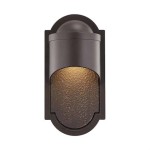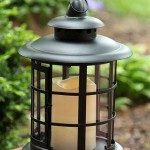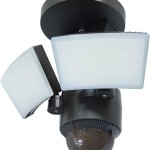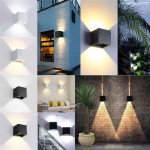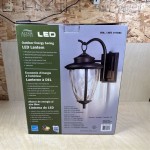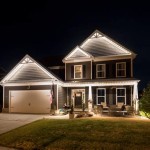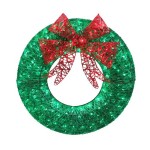Understanding the Diverse World of Outdoor Lighting
Outdoor lighting encompasses a broad spectrum of lighting fixtures and techniques designed to illuminate and enhance exterior spaces. It serves numerous purposes, from providing safety and security to creating ambiance and highlighting architectural features. Effective outdoor lighting requires careful consideration of factors like light source, fixture type, placement, and intended function. This article will explore different types of outdoor lighting, their applications, and the key considerations for choosing the right options for specific needs.
Types of Outdoor Lighting Fixtures
The variety of outdoor lighting fixtures can seem overwhelming, but understanding the basic categories makes the selection process more manageable. Each type serves a distinct purpose and offers unique benefits in terms of light output, style, and installation requirements.
Path Lighting: Path lighting is primarily designed to illuminate walkways, driveways, and garden paths. These fixtures are typically low to the ground and cast a soft, diffused light downwards, guiding foot traffic safely and preventing trips and falls. Path lights often utilize low-voltage systems for energy efficiency and ease of installation. Materials range from durable plastics to weather-resistant metals, ensuring longevity in outdoor environments. Styles vary widely, from traditional lantern designs to contemporary minimalist forms, allowing homeowners to complement their existing landscaping and architectural aesthetics.
Spotlights: Spotlights are characterized by their focused beam of light, which is ideal for highlighting specific features like trees, shrubs, architectural details, or sculptures. They often feature adjustable heads, allowing users to direct the light precisely where it's needed. Spotlights are available in various wattages to accommodate different distances and desired levels of brightness. They can be surface-mounted, ground-mounted, or even recessed into the ground for a more discreet appearance. The use of LED technology in spotlights has become increasingly common, offering energy efficiency and long lifespans.
Floodlights: Floodlights produce a broad, diffused beam of light, making them suitable for illuminating large areas like driveways, parking lots, and building facades. They typically deliver a higher light output than spotlights and are often used for security purposes, deterring intruders and enhancing visibility at night. Floodlights are available in various sizes and wattages, ranging from compact models for residential use to high-intensity units for commercial applications. Motion-activated floodlights are a popular choice for added security and energy savings.
Wall-Mounted Lights: Wall-mounted lights are attached to exterior walls, providing both ambient lighting and accent illumination. They can be used to highlight doorways, porches, patios, and other architectural features. Wall-mounted lights come in a diverse range of styles, from traditional lanterns and sconces to modern geometric designs. The choice of material is crucial for durability, with options like aluminum, stainless steel, and copper offering excellent weather resistance. Some wall-mounted lights incorporate photocells, which automatically turn the lights on at dusk and off at dawn, ensuring convenient and energy-efficient operation.
Post Lights: Post lights are mounted on top of posts or columns, providing a raised source of illumination. They are commonly used along driveways, walkways, and property boundaries. Post lights can add a touch of elegance and sophistication to outdoor spaces, particularly when chosen to complement the architectural style of the home. Like wall-mounted lights, they are available in a wide variety of styles, from classic Victorian designs to sleek modern interpretations. The height of the post is an important consideration, as it affects the overall light distribution and coverage area.
String Lights: String lights offer a decorative and festive lighting option, ideal for creating a warm and inviting ambiance in outdoor settings. They consist of a series of small bulbs strung together on a flexible cord. String lights are most often used on patios, decks, and pergolas, adding a touch of whimsy and charm to outdoor gatherings. They are available in various bulb styles, including traditional incandescent bulbs, energy-efficient LED bulbs, and decorative Edison-style bulbs. String lights can be easily hung from trees, fences, or other structures, allowing for flexible and creative lighting designs.
Deck Lights: Deck lights are specifically designed for illuminating decks and patios, providing both functional lighting and aesthetic appeal. They are typically low-voltage fixtures that can be integrated into the deck structure, such as the railing posts, stair risers, or deck surface. Deck lights create a safe and inviting atmosphere for outdoor entertaining. They are available in a variety of styles, including recessed lights, surface-mounted lights, and strip lights, allowing homeowners to customize the lighting to their specific needs and preferences. LED deck lights are a popular choice due to their energy efficiency and long lifespan.
Key Considerations for Selecting Outdoor Lighting
Choosing the right outdoor lighting involves several critical considerations beyond simply selecting a visually appealing fixture. Factors like safety, energy efficiency, light output, and compliance with local regulations must be carefully evaluated.
Safety and Security: One of the primary functions of outdoor lighting is to enhance safety and security. Well-lit pathways and entrances reduce the risk of accidents and deter potential intruders. Consider using motion-activated floodlights to illuminate dark areas and alert residents to any activity. Ensure that all outdoor lighting fixtures are properly installed and grounded to prevent electrical hazards. Compliance with local electrical codes is essential for safety and legal reasons. Regular maintenance, including checking for damaged wiring and replacing burned-out bulbs, is crucial for maintaining the effectiveness of the lighting system.
Energy Efficiency: Energy efficiency is an increasingly important consideration for outdoor lighting. Traditional incandescent bulbs consume a significant amount of energy and have a relatively short lifespan. Switching to LED lighting can significantly reduce energy consumption and lower electricity bills. LED bulbs also last much longer than incandescent bulbs, reducing the need for frequent replacements. Consider using timers or photocells to automatically turn lights on and off, optimizing energy use and minimizing waste. Solar-powered outdoor lighting is another energy-efficient option, which harnesses the power of the sun to provide illumination without the need for electrical wiring.
Light Output and Color Temperature: The amount of light produced by an outdoor lighting fixture is measured in lumens. The appropriate lumen output depends on the specific application. For example, path lighting requires a lower lumen output than floodlights. Color temperature refers to the color of the light emitted by a bulb, measured in Kelvin (K). Lower color temperatures (2700K-3000K) produce a warm, yellowish light, while higher color temperatures (4000K-5000K) produce a cooler, whiter light. The choice of color temperature depends on personal preference and the desired ambiance. Warm light is often preferred for residential settings, creating a cozy and inviting atmosphere. Cooler light is often used for security lighting, providing greater visibility.
Durability and Weather Resistance: Outdoor lighting fixtures are exposed to the elements, including rain, snow, sun, and wind. It is essential to choose fixtures that are designed to withstand these conditions. Look for fixtures made from durable materials like aluminum, stainless steel, and copper, which are resistant to corrosion and rust. Ensure that the fixtures have a weatherproof rating (IP rating) that indicates their ability to withstand moisture and dust. Regular cleaning and maintenance can help to prolong the lifespan of outdoor lighting fixtures and prevent damage. Consider the specific climate conditions in your area when selecting outdoor lighting fixtures.
Applications of Outdoor Lighting
Outdoor lighting can be strategically employed to serve a variety of purposes, enhancing both the functionality and aesthetics of outdoor spaces.
Landscape Lighting: Landscape lighting aims to highlight the natural beauty of gardens, trees, and shrubs. This can be achieved through techniques like uplighting, downlighting, and shadowing. Uplighting involves placing spotlights at the base of trees or shrubs, directing the light upwards to accentuate their shape and texture. Downlighting involves mounting lights in trees or under eaves, casting a soft, diffused light downwards to illuminate pathways and garden beds. Shadowing involves strategically placing lights to create interesting shadows and patterns on walls and fences. Landscape lighting can transform an ordinary garden into a captivating nighttime spectacle.
Security Lighting: Security lighting is primarily designed to deter intruders and enhance visibility around the perimeter of a property. Floodlights are commonly used for security lighting, providing a wide beam of light to illuminate large areas. Motion-activated lights are particularly effective for security purposes, automatically turning on when movement is detected. Consider installing lights near entrances, doorways, and windows to deter potential burglars. Ensure that the lights are positioned to minimize glare and avoid disturbing neighbors. Security lighting should provide adequate illumination without creating dark spots or shadows.
Architectural Lighting: Architectural lighting is used to highlight the architectural features of a building, such as columns, arches, and facades. This can be achieved through techniques like wall washing, grazing, and accent lighting. Wall washing involves uniformly illuminating a wall surface with a broad beam of light, creating a smooth and even appearance. Grazing involves directing light at a textured surface, such as brick or stone, to accentuate its irregularities and create visual interest. Accent lighting involves using spotlights to highlight specific architectural details. Architectural lighting can enhance the curb appeal of a building and create a sense of grandeur and sophistication.
Patio and Deck Lighting: Patio and deck lighting is designed to create a comfortable and inviting atmosphere for outdoor entertaining. String lights are a popular choice for patio and deck lighting, adding a touch of whimsy and charm. Deck lights can be integrated into the deck structure, providing both functional lighting and aesthetic appeal. Consider using dimmers to adjust the light level and create the desired ambiance. Patio and deck lighting should be both functional and decorative, enhancing the enjoyment of outdoor living spaces. Ensure that the lighting is well-placed to avoid glare and create a comfortable and relaxing atmosphere.

5 Outdoor Lighting Styles And Ideas Design Inspirations Lights Com Blog

Types Of Outdoor Landscape Lighting 7 Must Have Fixtures

Types Of Outdoor Landscape Lighting 7 Must Have Fixtures

19 Stylish Outdoor Lighting Ideas The Best Patio

10 Best Outdoor Lighting Ideas Landscape Design Secrets A Piece Of Rainbow

How To Choose The Right Outdoor Lights Tips Ideas

5 Outdoor Lighting Styles And Ideas Design Inspirations Lights Com Blog

The Skinny On Outdoor Lighting Stuff Co

How To Choose The Right Outdoor Lights Tips Ideas

Best Color Temperature For Outdoor Lighting Enhanced
Related Posts
